Lab Report: Examining Granite Formation and Composition
VerifiedAdded on 2022/08/15
|6
|783
|16
Report
AI Summary
This report provides a comprehensive analysis of granite formation, detailing the processes involved in its creation through tectonic plate activity and magma crystallization. It explores the rock's characteristics, including its texture, color, strength, and durability, which make it valuable for various applications such as construction, jewelry, and paving stones. The report also identifies the key minerals found in granite, such as quartz and feldspars, and highlights the aesthetic and practical importance of this rock. It concludes by summarizing the key learnings from the lab, emphasizing the understanding of granite formation, its significance, and its aesthetic appeal. Desklib provides a platform to access more solved assignments and resources for students.
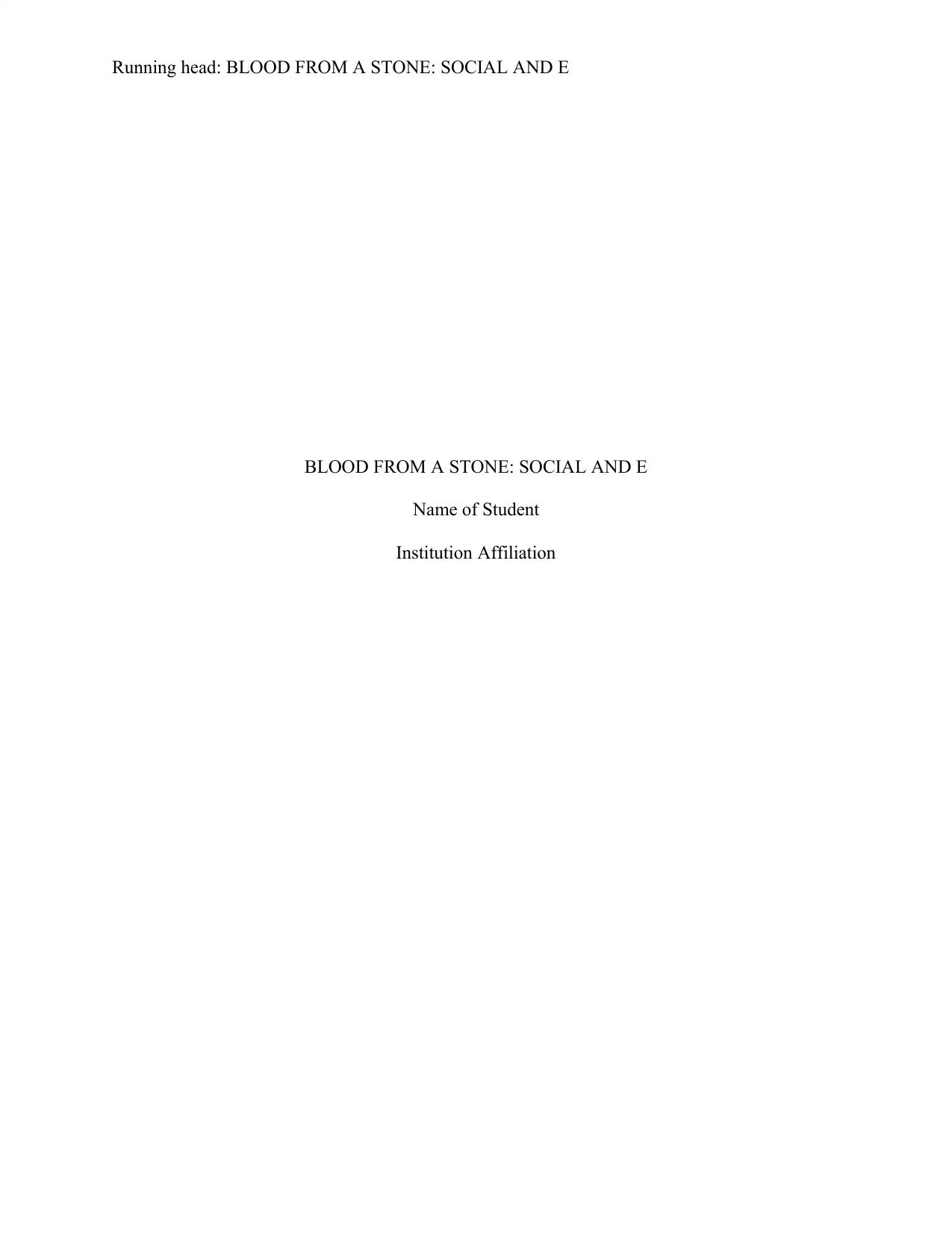
Running head: BLOOD FROM A STONE: SOCIAL AND E
BLOOD FROM A STONE: SOCIAL AND E
Name of Student
Institution Affiliation
BLOOD FROM A STONE: SOCIAL AND E
Name of Student
Institution Affiliation
Paraphrase This Document
Need a fresh take? Get an instant paraphrase of this document with our AI Paraphraser
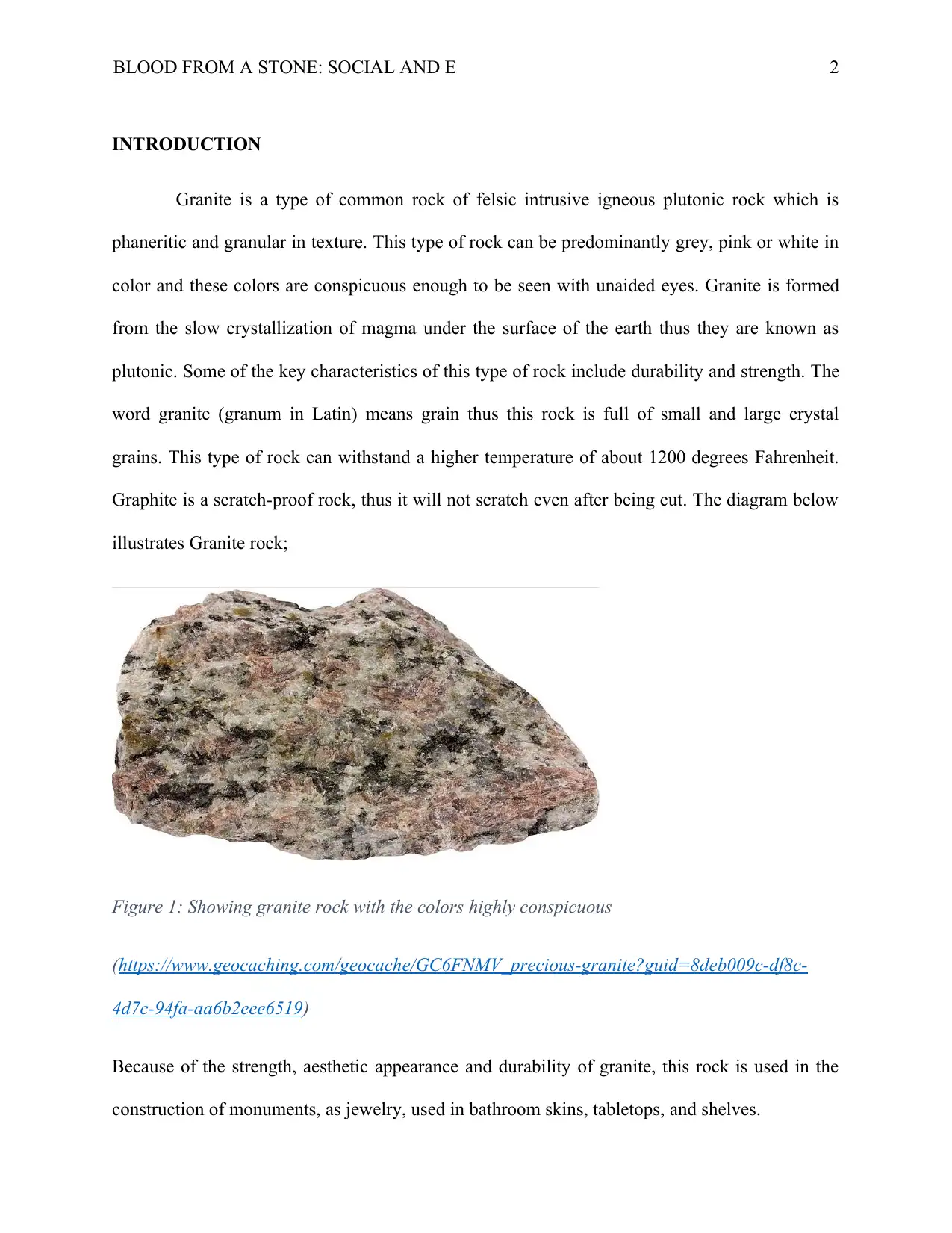
BLOOD FROM A STONE: SOCIAL AND E 2
INTRODUCTION
Granite is a type of common rock of felsic intrusive igneous plutonic rock which is
phaneritic and granular in texture. This type of rock can be predominantly grey, pink or white in
color and these colors are conspicuous enough to be seen with unaided eyes. Granite is formed
from the slow crystallization of magma under the surface of the earth thus they are known as
plutonic. Some of the key characteristics of this type of rock include durability and strength. The
word granite (granum in Latin) means grain thus this rock is full of small and large crystal
grains. This type of rock can withstand a higher temperature of about 1200 degrees Fahrenheit.
Graphite is a scratch-proof rock, thus it will not scratch even after being cut. The diagram below
illustrates Granite rock;
Figure 1: Showing granite rock with the colors highly conspicuous
(https://www.geocaching.com/geocache/GC6FNMV_precious-granite?guid=8deb009c-df8c-
4d7c-94fa-aa6b2eee6519)
Because of the strength, aesthetic appearance and durability of granite, this rock is used in the
construction of monuments, as jewelry, used in bathroom skins, tabletops, and shelves.
INTRODUCTION
Granite is a type of common rock of felsic intrusive igneous plutonic rock which is
phaneritic and granular in texture. This type of rock can be predominantly grey, pink or white in
color and these colors are conspicuous enough to be seen with unaided eyes. Granite is formed
from the slow crystallization of magma under the surface of the earth thus they are known as
plutonic. Some of the key characteristics of this type of rock include durability and strength. The
word granite (granum in Latin) means grain thus this rock is full of small and large crystal
grains. This type of rock can withstand a higher temperature of about 1200 degrees Fahrenheit.
Graphite is a scratch-proof rock, thus it will not scratch even after being cut. The diagram below
illustrates Granite rock;
Figure 1: Showing granite rock with the colors highly conspicuous
(https://www.geocaching.com/geocache/GC6FNMV_precious-granite?guid=8deb009c-df8c-
4d7c-94fa-aa6b2eee6519)
Because of the strength, aesthetic appearance and durability of granite, this rock is used in the
construction of monuments, as jewelry, used in bathroom skins, tabletops, and shelves.
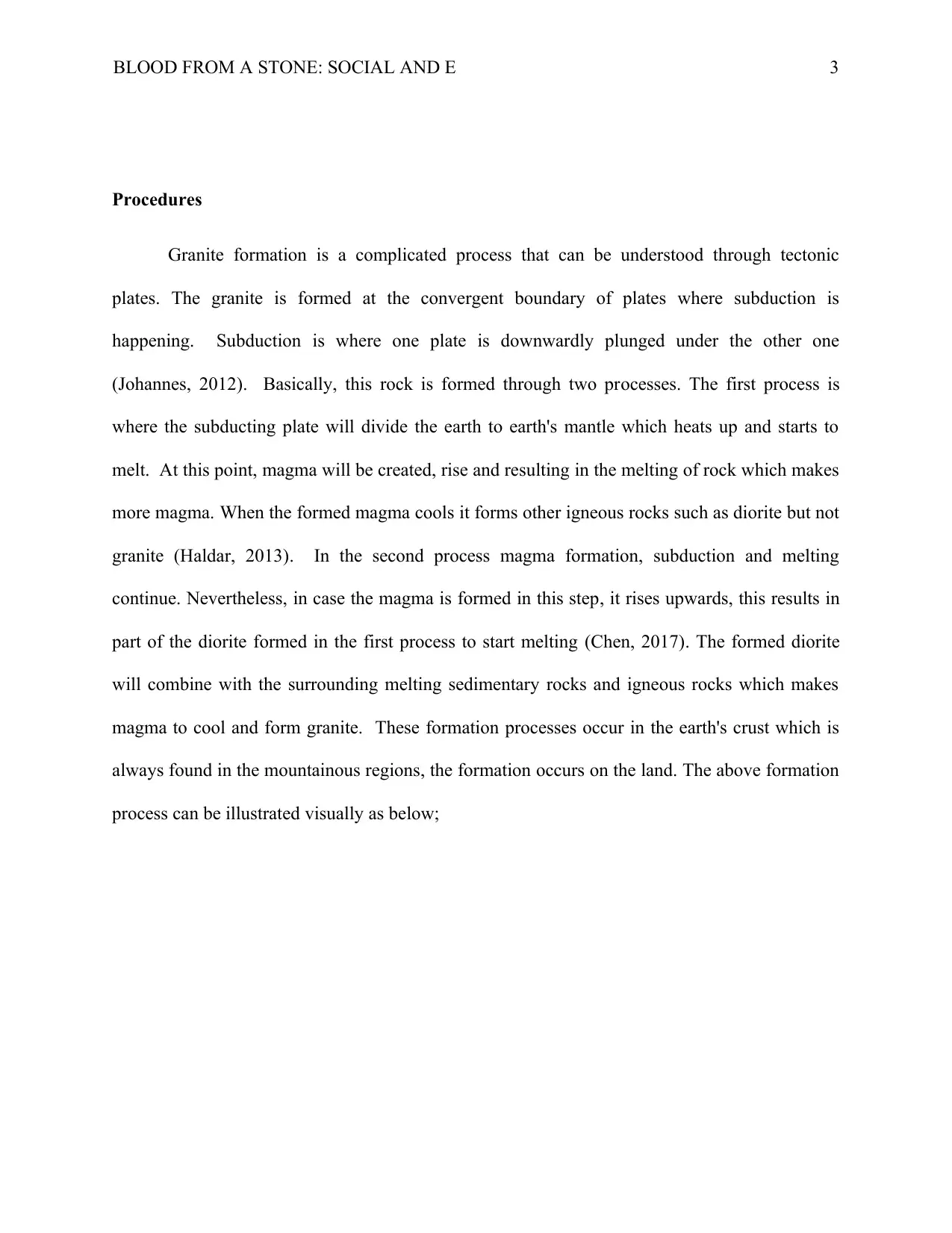
BLOOD FROM A STONE: SOCIAL AND E 3
Procedures
Granite formation is a complicated process that can be understood through tectonic
plates. The granite is formed at the convergent boundary of plates where subduction is
happening. Subduction is where one plate is downwardly plunged under the other one
(Johannes, 2012). Basically, this rock is formed through two processes. The first process is
where the subducting plate will divide the earth to earth's mantle which heats up and starts to
melt. At this point, magma will be created, rise and resulting in the melting of rock which makes
more magma. When the formed magma cools it forms other igneous rocks such as diorite but not
granite (Haldar, 2013). In the second process magma formation, subduction and melting
continue. Nevertheless, in case the magma is formed in this step, it rises upwards, this results in
part of the diorite formed in the first process to start melting (Chen, 2017). The formed diorite
will combine with the surrounding melting sedimentary rocks and igneous rocks which makes
magma to cool and form granite. These formation processes occur in the earth's crust which is
always found in the mountainous regions, the formation occurs on the land. The above formation
process can be illustrated visually as below;
Procedures
Granite formation is a complicated process that can be understood through tectonic
plates. The granite is formed at the convergent boundary of plates where subduction is
happening. Subduction is where one plate is downwardly plunged under the other one
(Johannes, 2012). Basically, this rock is formed through two processes. The first process is
where the subducting plate will divide the earth to earth's mantle which heats up and starts to
melt. At this point, magma will be created, rise and resulting in the melting of rock which makes
more magma. When the formed magma cools it forms other igneous rocks such as diorite but not
granite (Haldar, 2013). In the second process magma formation, subduction and melting
continue. Nevertheless, in case the magma is formed in this step, it rises upwards, this results in
part of the diorite formed in the first process to start melting (Chen, 2017). The formed diorite
will combine with the surrounding melting sedimentary rocks and igneous rocks which makes
magma to cool and form granite. These formation processes occur in the earth's crust which is
always found in the mountainous regions, the formation occurs on the land. The above formation
process can be illustrated visually as below;
⊘ This is a preview!⊘
Do you want full access?
Subscribe today to unlock all pages.

Trusted by 1+ million students worldwide
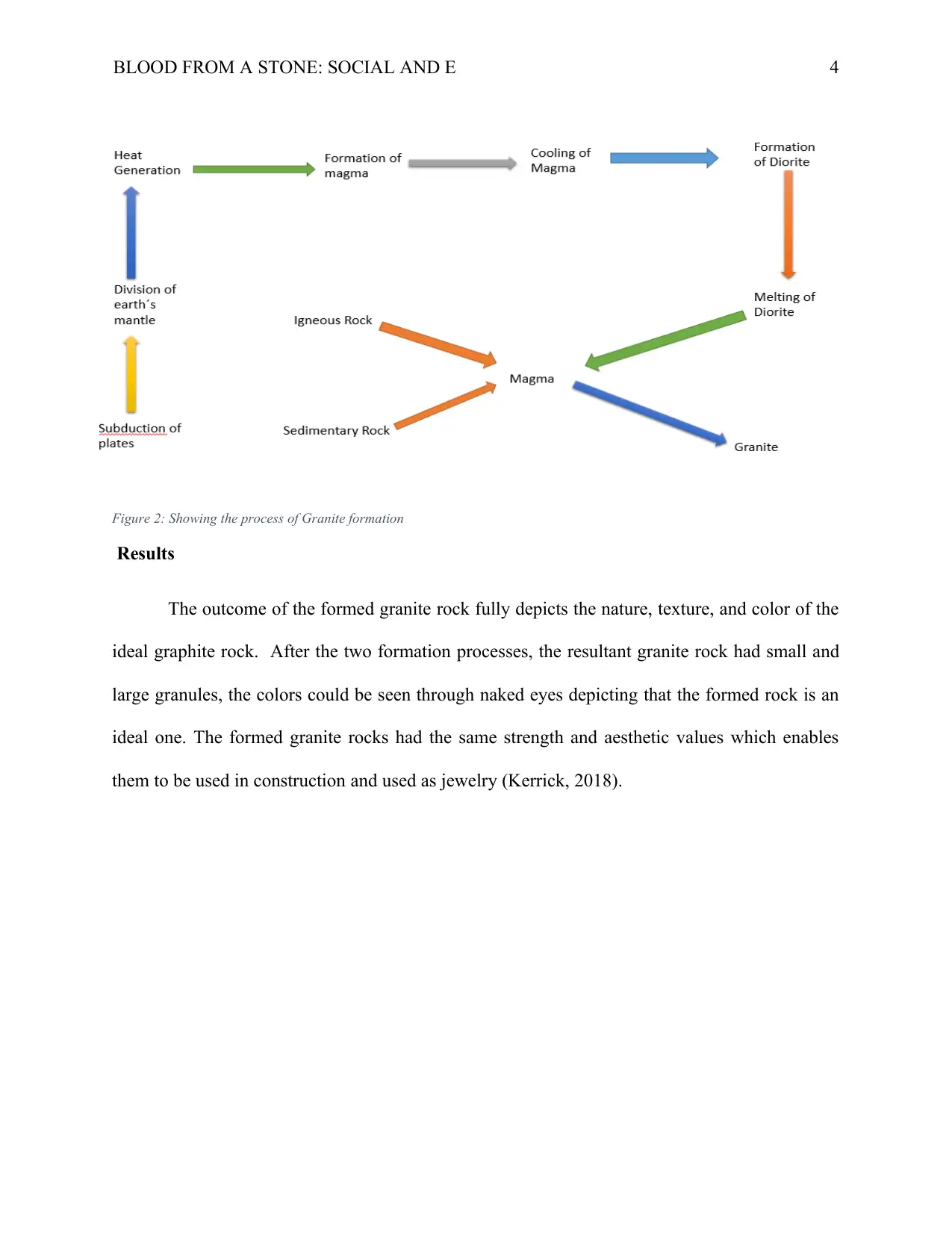
BLOOD FROM A STONE: SOCIAL AND E 4
Figure 2: Showing the process of Granite formation
Results
The outcome of the formed granite rock fully depicts the nature, texture, and color of the
ideal graphite rock. After the two formation processes, the resultant granite rock had small and
large granules, the colors could be seen through naked eyes depicting that the formed rock is an
ideal one. The formed granite rocks had the same strength and aesthetic values which enables
them to be used in construction and used as jewelry (Kerrick, 2018).
Figure 2: Showing the process of Granite formation
Results
The outcome of the formed granite rock fully depicts the nature, texture, and color of the
ideal graphite rock. After the two formation processes, the resultant granite rock had small and
large granules, the colors could be seen through naked eyes depicting that the formed rock is an
ideal one. The formed granite rocks had the same strength and aesthetic values which enables
them to be used in construction and used as jewelry (Kerrick, 2018).
Paraphrase This Document
Need a fresh take? Get an instant paraphrase of this document with our AI Paraphraser
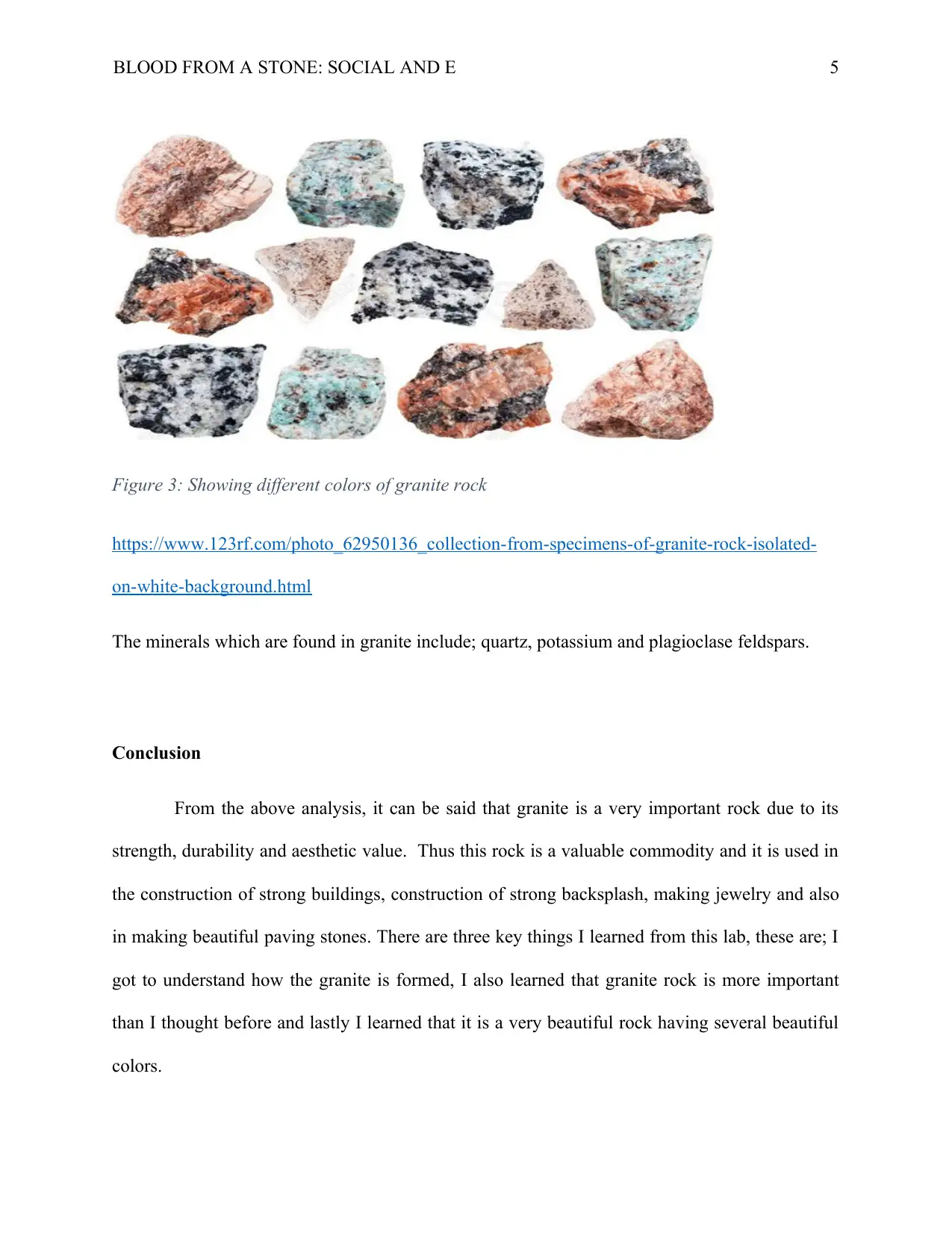
BLOOD FROM A STONE: SOCIAL AND E 5
Figure 3: Showing different colors of granite rock
https://www.123rf.com/photo_62950136_collection-from-specimens-of-granite-rock-isolated-
on-white-background.html
The minerals which are found in granite include; quartz, potassium and plagioclase feldspars.
Conclusion
From the above analysis, it can be said that granite is a very important rock due to its
strength, durability and aesthetic value. Thus this rock is a valuable commodity and it is used in
the construction of strong buildings, construction of strong backsplash, making jewelry and also
in making beautiful paving stones. There are three key things I learned from this lab, these are; I
got to understand how the granite is formed, I also learned that granite rock is more important
than I thought before and lastly I learned that it is a very beautiful rock having several beautiful
colors.
Figure 3: Showing different colors of granite rock
https://www.123rf.com/photo_62950136_collection-from-specimens-of-granite-rock-isolated-
on-white-background.html
The minerals which are found in granite include; quartz, potassium and plagioclase feldspars.
Conclusion
From the above analysis, it can be said that granite is a very important rock due to its
strength, durability and aesthetic value. Thus this rock is a valuable commodity and it is used in
the construction of strong buildings, construction of strong backsplash, making jewelry and also
in making beautiful paving stones. There are three key things I learned from this lab, these are; I
got to understand how the granite is formed, I also learned that granite rock is more important
than I thought before and lastly I learned that it is a very beautiful rock having several beautiful
colors.
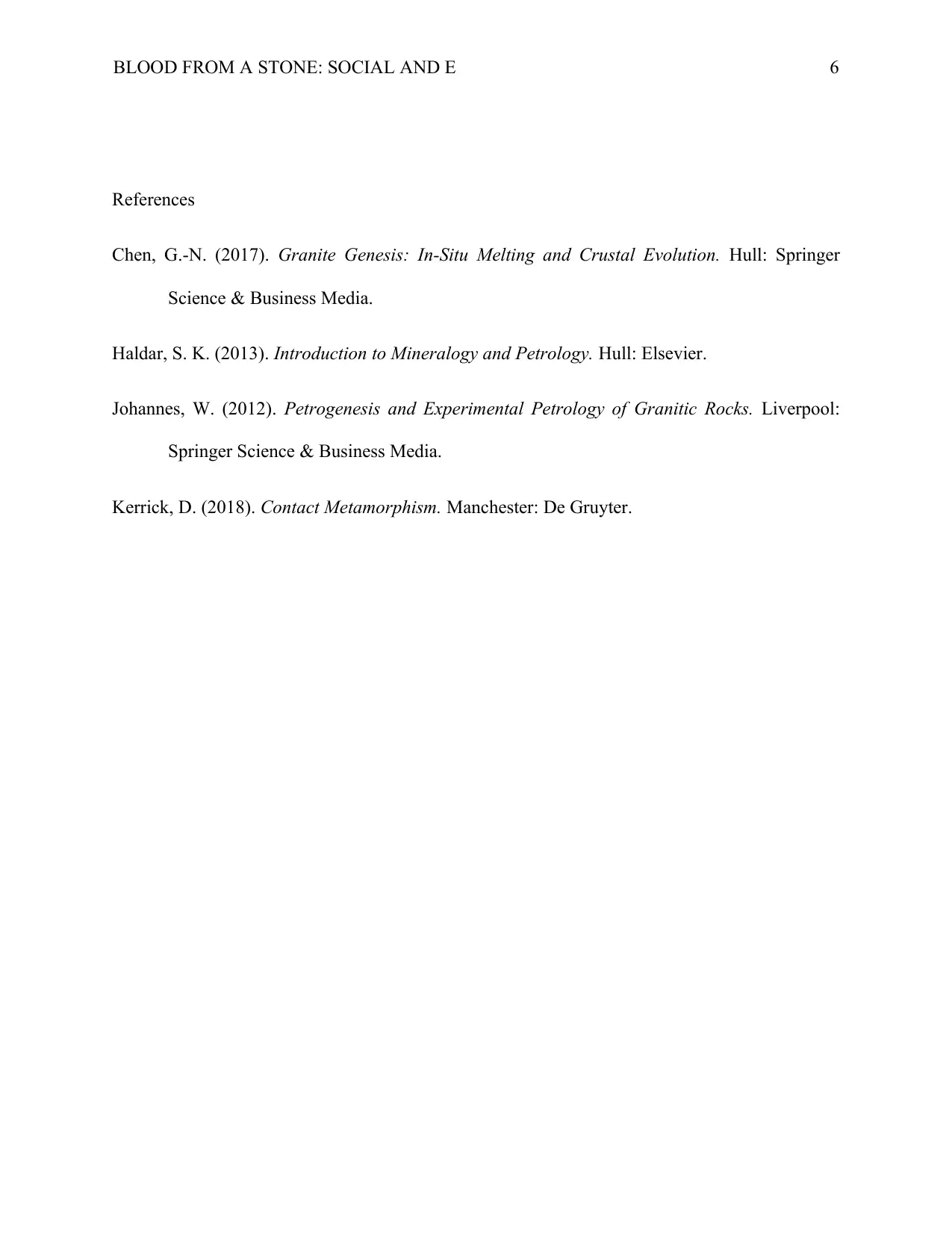
BLOOD FROM A STONE: SOCIAL AND E 6
References
Chen, G.-N. (2017). Granite Genesis: In-Situ Melting and Crustal Evolution. Hull: Springer
Science & Business Media.
Haldar, S. K. (2013). Introduction to Mineralogy and Petrology. Hull: Elsevier.
Johannes, W. (2012). Petrogenesis and Experimental Petrology of Granitic Rocks. Liverpool:
Springer Science & Business Media.
Kerrick, D. (2018). Contact Metamorphism. Manchester: De Gruyter.
References
Chen, G.-N. (2017). Granite Genesis: In-Situ Melting and Crustal Evolution. Hull: Springer
Science & Business Media.
Haldar, S. K. (2013). Introduction to Mineralogy and Petrology. Hull: Elsevier.
Johannes, W. (2012). Petrogenesis and Experimental Petrology of Granitic Rocks. Liverpool:
Springer Science & Business Media.
Kerrick, D. (2018). Contact Metamorphism. Manchester: De Gruyter.
⊘ This is a preview!⊘
Do you want full access?
Subscribe today to unlock all pages.

Trusted by 1+ million students worldwide
1 out of 6
Your All-in-One AI-Powered Toolkit for Academic Success.
+13062052269
info@desklib.com
Available 24*7 on WhatsApp / Email
![[object Object]](/_next/static/media/star-bottom.7253800d.svg)
Unlock your academic potential
Copyright © 2020–2025 A2Z Services. All Rights Reserved. Developed and managed by ZUCOL.


